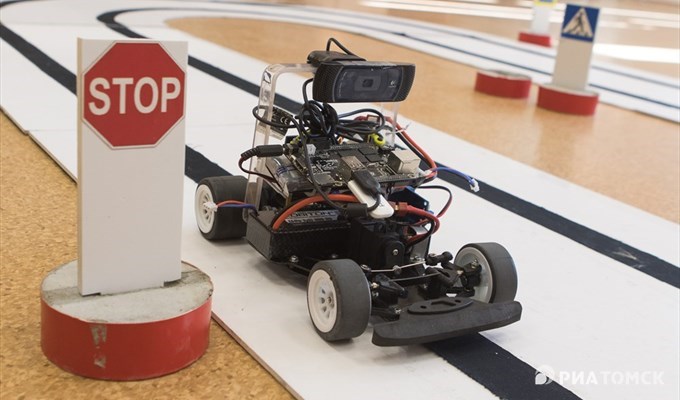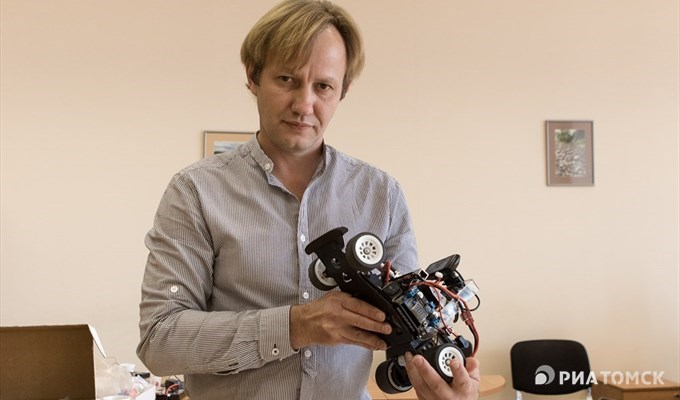TOMSK, Apr 13 – RIA
Tomsk. New
technology to control autonomous vehicles is created by the Tomsk Elecard
company. It is a cloud, a kind of "taken-out brain" that can manage
objects remotely in real time. This, on the one hand, will make the roads of
the future safer, on the other – will reduce the energy costs of the robots
themselves. Details – in the material of RIA Tomsk.
How does autonomous
vehicles develop
There are two basic
concepts in the development of unmanned vehicles. One suggested by the
Japanese, who believe that it is necessary to build an active infrastructure.
That is, on every section of the road, on a sign, on every obstacle, there
should be active sensors which signal the car: "There is such a
restriction". But it's clear what's the costs of this ...
The second concept assumes
that the car itself can navigate in space, with the help of so-called technical
vision, based on sensor of video cameras. To do this, its built-in
"brain" (mobile processor) must be taught to recognize signs,
obstacles, pedestrians and other machines.
"And here arises the
question: either to train this particular mobile brain and constantly adapt it,
or give it the opportunity, firstly, to share the accumulated experience with
some external system (conditionally speaking, the "taken-out brain"),
and secondly, to take from this system recommendations for the movement",
– says the Elecard nanoDevices director of development Victor Shirshin.
In the future, he says,
there will be hundreds and thousands of times more unmanned objects, and if to
add another third coordinate - when they start taking off - then the task of
safely "breaking through" this traffic can be too complicated for the
built-in "brain".
"That's why we had the
idea of an external moderator, and we discussed and implemented a partially
taken out algorithm of artificial intelligence. In essence it is a distributed
cloud of information, an artificial intelligence which can optimally organize
the logistics of the movement", – says Shirshin.
© РИА Томск. Павел Стефанский
Elecard begun to deal with systems of technical vision about three years ago. It is necessary not only for an autonomous vehicles, but for any self-moving object - anthropomorphic robot, garbage collector, etc.
Say, the drone is on the
road. The system determines that now another unmanned object will "come
up" on the right, and makes recommendations to change the speed or make a
maneuver. At the same time, the "mobile brain" on board does not
spend energy for its own calculations.
What technologies
are needed to make the "taken-out brain" work
The reaction time of an
ordinary driver to an abnormal situation – is about one second.
For a robotic system, this
is impermissible: it should react almost instantly. That is, the signal
"from the brain to the brain" should be transmitted with a minimum
delay, and for this, according to Shirshin, the next generation of
communication should appear - 5G, where this value is only one millisecond
(that is, one thousandth of a second).
"The introduction of
5G will allow us to manage the fast moving objects online. We expect that the
new standard will be adopted by about 2020", – he said.
The speed of data
processing must also change qualitatively, because thousands of millions of
self-moving objects will be connected to the remote control system, the behavior
of each one should be analyzed constantly.
"And here, too, there
are good news: at the end of March in San Jose, NVIDIA company (the leader in
computing for artificial intelligence) introduced a number of innovations that
will multiply the performance of computing boards and at the same time reduce
the energy costs of computing by 18 times. It is a revolutionary step to the
future!", – Shirshin emphasizes.
The vice rector for
innovative activity of Tomsk State University (TSU) Konstantin Belyakov confirms:
"5G technology will
radically change the interaction of self-moving, self-changing, self-conscious,
decision-making robots and Robots (with capital letter one write about robots
with the subject right to make their own decisions)".
He admits that at this
stage Russia is unlikely to bring anything substantial into the 5G theme
described by the 3GPP alliance: we do not have our own concept of developing
the fifth generation cellular equipment and, most likely, it is already useless
to catch up here. But to compete in technologies on the basis of this future
standard, we can:
"One can ask: why do
this, if it is possible to use it ready? I think it's simply vital - it's
important for us to avoid technological colonial dependence. We either go ahead
or at keep abreast with the whole world and work out the rules of the game
together, or after a while just obey the rules imposed on us", - Belyakov
said.
What is done for
this in Tomsk
The head of the Tomsk
cluster "Information Technologies and Electronics of the Tomsk
region" Igor Sokolovsky tells that a number of collectives works on
technical vision (synthetic vision system) in the region: RPC "Technique
of Business", "DiViLine", "Intec", "Software
Crystal", "Popkov Robotics" (enters the Elekard Group) companies
and also three scientific groups at TUSUR and one at TSU.
He believes that in the
narrow segments of technical vision this is the world level of developments:
"For example, the
"Technique of Business" develops face recognition systems based on
neural networks of deep learning, "Intec" - augmented reality for
technical vision. The laboratory of television devices of TUSUR deals with
stroboscopic vision systems that allow to see through the fog. Yakubov's
laboratory at TSU specializes in radio vision, developing radars for building a
3D map of space".
Victor Shirshin says that
the competence of all companies involved in systems based on technical vision,
can help in implementing the idea of a global "taken-out brain":
"It's not the main
problem to write software directly for artificial intelligence. It's much more
difficult to gather information on the basis of which this artificial
intelligence will be trained. At one time we tried to use machines with
technical vision for this purpose, which our company - "Popkov
Robotics" - did for educational robotics designers".
He explains:
"These machines are
distributed to a large number of users, each of them goes along symbolic roads
with different conditions (lighting, glare, obstacles), this experience can
accumulate and collect in one place. And this distributed database can be used
by every newly connected artificial intelligence. It's as if the child, having
barely been born, already received all the experience of ancestors, could walk,
talk, know the traffic rules".
Now, "Elecard"
scales this idea: it initiated the creation of the Alliance of companies of
technical vision, which includes developers of systems based on technical
vision. It has already joined 13 members, so far only from Russia (although
there is a plan to make it international). The alliance is the part of the
Tomsk cluster of SMART Technologies.
"Each company of the
alliance is developing in its narrow sector related to technical vision. Today
we have already developed a fairly wide range of developments. And as soon as
we will be able to consolidate them in one program space so that they easily
integrate with each other, each company entering the alliance, will receive the
competence of all members of the alliance", – Shirshin said.
In
Tomsk, a part of the cloud, where knowledge will be accumulated, was placed in
one of the Data Processing Centers of Tomsk State University. The same will
then appear in different parts of the country.
© РИА Томск. Павел Стефанский
Victor Shirshin:: "It is not a problem to connect robots to the cloud in the future. But people have to be persuaded to join the alliance, because everyone wants to be the first. But breakthrough technological issues must be solved in cooperation. On one’s own man can lose".